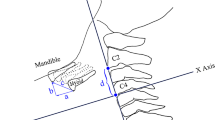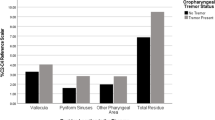Abstract
Drooling is a frequently reported symptom in Parkinson’s Disease (PD) with significant psychosocial impact and negative health consequences including silent aspiration of saliva with the associated risk of respiratory infections. It is suggested that in PD drooling is associated with inefficient oropharyngeal swallowing which reduces the effective clearance of saliva rather than hyper-salivation. This is compounded by unintended mouth opening and flexed posture increasing anterior loss of saliva. It is reported to occur most frequently during cognitively distracting concurrent tasks suggesting an impact from divided attention in a dual-task situation. However, this supposition has not been systematically examined. This study assessed whether frequency of saliva swallows reduced, and drooling severity and frequency increased, when people with PD engaged in a cognitively distracting task. 18 patients with idiopathic PD reporting daytime drooling on the Unified Parkinson’s Disease Rating Scale (UPDRS) were recruited. They completed the Radboud Oral Motor Inventory for PD saliva questionnaire and the Montreal Cognitive Assessment. UPDRS drooling score, disease stage, duration, gender, and age were recorded. Swallow frequency and drooling severity and frequency were measured at rest and during a distracting computer-based language task. There was no significant difference between drooling severity at rest and during distraction (Wilcoxon signed rank test z = − 1.724, p = 0.085). There was a significant difference between at rest and distraction conditions for both drooling frequency (Wilcoxon signed rank test z = − 2.041, p = 0.041) and swallow frequency (Wilcoxon signed rank test z = − 3.054, p = 0.002). Participants swallowed less frequently and drooled more often during the distraction task. The frequency of saliva swallows and drooling are affected by divided attention in a dual-task paradigm. Further studies are needed to explore the exact role of attention in saliva management and the clinical applications in assessment and treatment.
Similar content being viewed by others
References
Kalf JG, Bloem BR, Munneke M. Diurnal and nocturnal drooling in Parkinson’s disease. J Neurol. 2012;259(1):119–23.
Srivanitchapoom P, Pandey S, Hallett M. Drooling in Parkinson’s disease: a review. Parkinsonism Relat Disord. 2014;20(11):1109–18.
Kalf J, Smit A, Bloem B, Zwarts M, Munneke M. Impact of drooling in Parkinson’s disease. J Neurol. 2007;2007(254):1227–32.
Leibner J, Ramjit A, Sedig L, Dai Y, Wu SS, Jacobson C, Okun MS, Rodriguez RL, Malaty IA, Fernandez HH. The impact of and the factors associated with drooling in Parkinson’s disease. Parkinsonism Relat Disord. 2010;16(7):475–7.
Nobrega AC, Rodrigues B, Melo A. Is silent aspiration a risk factor for respiratory infection in Parkinson’s disease patients? Parkinsonism Relat Disord. 2008;14:643–8.
Rajaei A, Ashtari F, Azargoon SA, Chitsaz A, Nilforoush MH, Taheri M, Sadeghi S. The association between saliva control, silent saliva penetration, aspiration, and videofluoroscopic findings in Parkinson’s disease patients. Adv Biomed Res. 2015. https://doi.org/10.4103/2277-9175.157815.
Kalf JG, Munneke M, van den Engel-Hoek L, de Swart BJ, Borm GF, Bloem BR, Zwarts MJ. Pathophysiology of diurnal drooling in Parkinson’s disease. Mov Disord. 2011;26(9):1670–6.
Evatt ML, Chaudhuri K, Chou KL, Cubo E, Hinson V, Kompoliti K, Yang C, Poewe W, Rascol O, Sampaio C, Stebbins GT. Dysautonomia rating scales in Parkinson’s disease: sialorrhea, dysphagia, and constipation—critique and recommendations by movement disorders task force on rating scales for Parkinson’s disease. Mov Disord. 2009;24(5):635–46.
Kalf JG, Borm GF, de Swart BJ, Bloem BR, Zwarts MJ, Munneke M. Reproducibility and validity of patient-rated assessment of speech, swallowing, and saliva control in Parkinson’s disease. Arch Phys Med Rehabil. 2011;92(7):1152–8.
Pehlivan M, Yüceyar N, Ertekin C, Çelebi G, Ertaş M, Kalayci T, Aydoğdu I. An electronic device measuring the frequency of spontaneous swallowing: digital phagometer. Dysphagia. 1996;11(4):259–64.
Hyson HC, Johnson AM, Jog MS. Sublingual atropine for sialorrhea secondary to Parkinsonism: a pilot study. Mov Disord. 2002;17(6):1318–20.
Arbouw M, Movig K, Koopmann M, Poels P, Guchelaar H, Egberts T, Neef C, van Vugt J. Glycopyrrolate for sialorrhea in Parkinson disease; a randomized, double-blind, crossover trial. Neurology. 2010;74:1203–7.
Perez-Lloret S, Nègre-Pagès L, Ojero-Senard A, Damier P, Destee A, Tison F, Merello M, Rascol O. Oro-buccal symptoms (dysphagia, dysarthria, and sialorrhea) in patients with Parkinson’s disease: preliminary analysis from the French COPARK cohort. Eur J Neurol. 2012;19(1):28–37.
Marks L, Turner K, O’Sullivan J, Deighton B, Lees A. Drooling in Parkinson’s disease: a novel speech and language therapy intervention. Int J Lang Commun Disord. 2001;36:282–7.
McNaney R, Lindsay S, Ladha K, Ladha C, Schofield G, Ploetz T, Hammerla N, Jackson D, Walker R, Miller N, Olivier P. Cueing for drooling in Parkinson’s disease. In: Proceedings of the SIGCHI conference on Human Factors in Computing Systems. ACM; 2011. pp. 619–622.
South AR, Somers SM, Jog MS. Gum chewing improves swallow frequency and latency in Parkinson patients: a preliminary study. Neurology. 2010;74(15):1198–202.
Sarra N, Siderowf A, Duda J, Ten Have T, Colcher A, Horn S, Moberg P, Wilkinson JR, Hurtig HI, Stern MB, Weintraub D. Montreal cognitive assessment performance in patients with Parkinson’s Disease with “Normal” global cognition according to mini mental state examination score. J Am Geriatr Soc. 2009;57(2):304–8.
Kudlicka A, Clare L, Hindle JV. Pattern of executive impairment in mild to moderate Parkinson’s disease. Dement Geriatr Cogn Disord. 2013;36(1–2):50–66.
Stojmenovic GM, Stefanova E, Stojkovic T, Tomic A, Markovic V, Lukic MJ, Kresojevic N, Stankovic I, Kostic V. Attentional flexibility deficits in Parkinson’s disease patients with freezing of gait. Mov Disord. 2014;29:S354–5.
Dromey C, Jarvis E, Sondrup S, Nissen S, Foreman KB, Dibble LE. Bidirectional interference between speech and postural stability in individuals with Parkinson’s disease. Int J Speech Lang Pathol. 2010;12(5):446–54.
Yogev-Seligmann G, Hausdorff JM, Giladi N. The role of executive function and attention in gait. Mov Disord. 2008;23(3):329–42.
Muralidharan V, Balasubramani PP, Chakravarthy S, Gilat M, Lewis SJ, Moustafa AA. A neurocomputational model of the effect of cognitive load on freezing of gait in parkinson’s disease. Front Hum Neurosci. 2016;10:649.
Brodsky MB, Abbott KV, McNeil MR, Palmer CV, Grayhack JP, Martin-Harris B. Effects of divided attention on swallowing in persons with idiopathic Parkinson’s disease. Dysphagia. 2012;27(3):390–400.
Troche MS, Okun MS, Rosenbek JC, Altmann LJ, Sapienza CM. Attentional resource allocation and swallowing safety in Parkinson’s disease: a dual task study. Parkinsonism Relat Disord. 2014;20(4):439–43.
Rana A, Khondker S, Kabir A, Owalia A, Emre M. Impact of cognitive dysfunction on drooling in Parkinson’s disease. Eur J Neurol. 2013;70(1–2):42–5.
Goetz CG, Tilley BC, Shaftman SR, Stebbins GT, Fahn S, Martinez-Martin P, Poewe W, Sampaio C, Stern MB, Dodel R, Dubois B. Movement Disorder Society-sponsored revision of the Unified Parkinson’s Disease Rating Scale (MDS-UPDRS): scale presentation and clinimetric testing results. Mov Disord. 2008;23(15):2129–70.
Hughes AJ, Daniel SE, Kilford L, Lees AJ. Accuracy of clinical diagnosis of idiopathic Parkinson’s disease: a clinico-pathological study of 100 cases. J Neurol Neurosurg Psychiatry. 1992;55(3):181–4.
Hoehn M, Yahr M. Parkinsonism: onset, progression and mortality. Neurology. 1967;17:427–42.
Nasreddine ZS, Phillips NA, Bédirian V, Charbonneau S, Whitehead V, Collin I, Cummings JL, Chertkow H. The Montreal Cognitive Assessment, MoCA: a brief screening tool for mild cognitive impairment. J Am Geriatr Soc. 2005;53(4):695–9.
Gernsbacher MA, Faust ME. The mechanism of suppression: a component of general comprehension skill. J Exp Psychol Learn Mem Cogn. 1991;17:245.
Thomas-Stonell N, Greenberg J. Three treatment approaches and clinical factors in the reduction of drooling. Dysphagia. 1988;3(2):73–8.
Banerjee KJ, Glasson C, O’Flaherty SJ. Parotid and submandibular botulinum toxin A injections for sialorrhoea in children with cerebral palsy. Dev Med Child Neurol. 2006;48(11):883–7.
Mancini F, Zangaglia R, Cristina S, Sommaruga MG, Martignoni E, Nappi G, Pacchetti C. Double-blind, placebo-controlled study to evaluate the efficacy and safety of botulinum toxin type A in the treatment of drooling in Parkinsonism. Mov Disord. 2003;18(6):685–8.
Ondo WG, Hunter C, Moore W. A double-blind placebo-controlled trial of botulinum toxin B for sialorrhea in Parkinson’s disease. Neurology. 2004;62(1):37–40.
Boersma P, Weenink D. Praat: doing phonetics by computer [Computer program]. Version 6.0.19; 2016. http://www.praat.org/. Accessed 13 June 2016.
Santamato A, Panza F, Solfrizzi V, Russo A, Frisardi V, Megna M, Ranieri M, Fiore P. Acoustic analysis of swallowing sounds: a new technique for assessing dysphagia. J Rehabil Med. 2009;41(8):639–45.
Norman DA, Shallice T. Attention to action. In: Consciousness and self-regulation. Springer, Berlin; 1986. pp. 1–18.
Wu T, Liu J, Zhang H, Hallett M, Zheng Z, Chan P. Attention to automatic movements in Parkinson’s disease: modified automatic mode in the striatum. Cereb Cortex. 2015;25(10):3330–42.
LaPointe LL, Stierwalt JA, Maitland CG. Talking while walking: cognitive loading and injurious falls in Parkinson’s disease. Int J Speech Lang Pathol. 2010;12(5):455–9.
Nieuwhof F, Bloem BR, Reelick MF, Aarts E, Maidan I, Mirelman A, Hausdorff JM, Toni I, Helmich RC. Impaired dual tasking in Parkinson’s disease is associated with reduced focusing of cortico-striatal activity. Brain. 2017;140(5):1384–98.
Clark JP, Adams SG, Dykstra AD, Moodie S, Jog M. Loudness perception and speech intensity control in Parkinson’s disease. J Commun Disord. 2014;51:1–12.
Parveen S. Comparison of self and proxy ratings for motor performance of individuals with Parkinson disease. Brain Cogn. 2016;103:62–9.
Noble E, Jones D, Miller N. Patient reported changes to swallowing in Parkinson’s disease. Int J Ther Rehabil. 2015;22(12):573–81.
Parker C, Power M, Hamdy S, Bowen A, Tyrrell P, Thompson DG. Awareness of dysphagia by patients following stroke predicts swallowing performance. Dysphagia. 2004;19(1):28–35.
De Lau LM, Breteler MM. Epidemiology of Parkinson’s disease. Lancet Neurol. 2006;5(6):525–35.
Jenkinson C, Fitzpatrick RAY, Peto VIV, Greenhall R, Hyman N. The Parkinson’s disease Questionnaire (PDQ-39): development and validation of a Parkinson’s disease summary index score. Age Ageing. 1997;26(5):353–7.
McCaig CM, Adams SG, Dykstra AD, Jog M. Effect of concurrent walking and interlocutor distance on conversational speech intensity and rate in Parkinson’s disease. Gait Posture. 2016;43:132–6.
Heinzel S, Maechtel M, Hasmann SE, Hobert MA, Heger T, Berg D, Maetzler W. Motor dual-tasking deficits predict falls in Parkinson’s disease: a prospective study. Parkinsonism Relat Disord. 2016;26:73–7.
Strouwen C, Molenaar EA, Keus SH, Münks L, Heremans E, Vandenberghe W, Bloem BR, Nieuwboer A. Are factors related to dual-task performance in people with Parkinson’s disease dependent on the type of dual task? Parkinsonism Relat Disord. 2016;23:23–30.
Kelly VE, Eusterbrock AJ, Shumway-Cook A. A review of dual-task walking deficits in people with Parkinson’s disease: motor and cognitive contributions, mechanisms, and clinical implications. Parkinson’s Dis. 2012. https://doi.org/10.1155/2012/918719.
Acknowledgements
Grateful thanks are due to Keith Gray for his support with the study statistics and to the clinical teams and their patients who supported the project.
Funding
No funding was received for the research itself; however, the project was completed as part of a Masters in Clinical Research by the primary author with funding from a Masters Studentship from the Royal College of Speech and Language Therapists.
Author information
Authors and Affiliations
Corresponding author
Ethics declarations
Conflict of interest
There are no known conflicts of interest.
Rights and permissions
About this article
Cite this article
Reynolds, H., Miller, N. & Walker, R. Drooling in Parkinson’s Disease: Evidence of a Role for Divided Attention. Dysphagia 33, 809–817 (2018). https://doi.org/10.1007/s00455-018-9906-7
Received:
Accepted:
Published:
Issue Date:
DOI: https://doi.org/10.1007/s00455-018-9906-7




